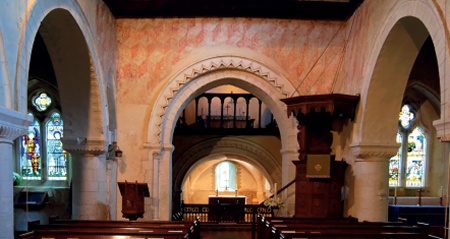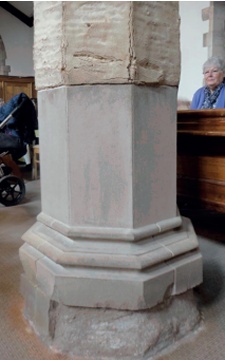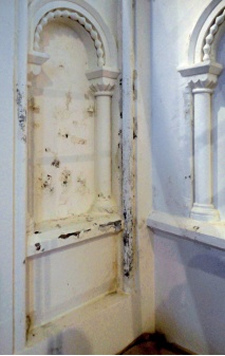Interior Decoration and Permeability
Mark Parsons
 |
|
| Lime-washed permeable walls of St Nicholas Church, Compton, Surrey with a simple medieval decorative scheme |
Most churches and chapels constructed before the first world war have solid masonry walls. When first constructed, these walls were breathable, inside and out, because they were built using permeable lime mortars and their interiors were usually lime plastered and finished with limewash. These simple lime-based materials helped the walls to dry quickly.
Following the development of fast-setting cements in the 19th century and of cheaper more durable synthetic paint systems in the 20th, routine repairs led to the interior surfaces of many churches being effectively sealed. As the long term consequences of this were not widely understood until late in the 20th century, few churches have escaped.
Typical results include areas of blistering and peeling paint, black mildewed north easterly and westerly corners, drip stains beneath wall-heads and valley gutters, and mildewed and stained stone window surrounds. Add to this the glossy sheen of the walls and the rusted-up window vents, and the church surveyor is faced with a virtual Rubik’s cube of related issues.
Today, when a churchwarden or PCC asks for advice on redecorating the church interior walls, the answer to this apparently simple question suddenly becomes extraordinarily complex. You cannot ‘simply’ restore a vapour permeable painted surface either ‘technically’ or in the case of more ancient structures ‘conservatively’. The advice given has to be based on an understanding of the church’s interior environment, whether damp, dry, airy or humid. The external condition of the church would require assessment before good advice could be given or the specification process begun. If this is a ‘one-off’ commission or you are a newly appointed church architect, an initial inspection of the fabric is best followed by a study of past quinquennial inspection reports or possibly the church’s log book. These documents should provide information on any ‘progressive’ repairs that have occurred and will help to identify longer term problems.
The level of ‘dampness’ in a church building is largely a result of the actions (and inaction) of its managers and occupants over time. This level is best expressed in terms of relative humidity (at 100% relative humidity or ‘RH’, air of a given temperature cannot hold any more moisture): churches typically average 80 to 100 per cent RH in the UK, with average internal RH readings of around 90 per cent being considered high. Drying rates are mainly affected by the amount of sunlight entering into the building, the movement of warmed air and the permeability of its fabric.
 |
|
| Solid concrete floors following a 20th-century rebuild; note how the moisture travels up through the renewed stonework and forms a salty crust on the original fabric. |
If the floor is impermeable to water vapour due to ground conditions or modern interventions (such as a plastic DPM and/or concrete slab, or impervious coverings such as rubber backed carpets) the result will, no doubt, be rising damp at the base of the walls and columns and the crystallisation of salts (efflorescence). Poorly detailed and badly maintained roof abutment and drainage, together with general orientation and exposure, are often the primary sources of the rainwater penetration which causes internal peeling paints, salting, and ‘black spot’ mildew and plaster surface degradation.
Poor ventilation can lead to condensation on painted wall surfaces, usually at high level in northerly corners and typically indicated by black spot mildew growth. White mildew is a powdery fungus which is more apparent on damp timber surfaces and appears on furnishings and ceiling boards. You may also see evidence of high humidity on window panes with wet surfaces and extensive green algal growth. Stone window surrounds will also be prone to black spot mildew. Ventilation of church interior spaces and suspended timber floor structures must be understood and action taken to maintain through-ventilation.
Salting and surface paint loss can also be caused by an interaction between modern plasterwork and either open external mortar joints or those closed with hard cement mortars. Normally at high or low levels and around windows and door openings some re-plastering will have taken place using modern moisture absorbing plasters, which are generally termed ‘Carlite’ or ‘pink’ or ‘browning’. These have been used as a quick low-cost solution to failing plasterwork at higher level (particularly over the chancel arch) or degrading and loosening plasters at low level. They are quick and easy to apply.
Where wall plaster must be replaced, it is best to use fibre-reinforced
natural lime plasters. However, in some
circumstances an alternative proprietary
lime-rich renovating
plaster mix may be
used. Limelite for example contains both
lime and fibrous reinforcement, albeit
with a small amount of cement. When
set, these plasters have a light and open
structure that allows water vapour to
pass through. There are mixes suitable
for upper and lower wall conditions, and
the skim coat adheres particularly well to
all types of surface, even those which are
impermeable. The manufacturers offer
good technical guidance and support.
Proprietary lime-rich renovating plasters such as Limelite are best used in the following circumstances:
- where working at high level – wall and ceiling-renovating plasters are lighter weight and will penetrate crevices and timber lath more readily
- where the underlying masonry is particularly hard, impermeable and smooth
- as a skim coat where the surface surrounding the repair is inconsistent, particularly in terms of permeability, and where it is important to provide a smooth overall appearance
- where it is necessary to work at cold temperatures (around 10°C) and/or with high humidity and/or in poorly ventilated spaces.
One other cause of poor paint adhesion is the use of inappropriate paints to cover traditional finishes such as limewash, casein-based paints and whiting. Where this is identified as a problem and the church is ancient or from a period when complex decorative schemes were popular, care must be taken when offering advice on recoating. In these cases you are required to assume the possibility of underlying paint schemes that might be restored at a future date.
Wet penetration caused by a poorly maintained surface water drainage system or a system that does not have sufficient capacity to control the level of water runoff in heavy rainfall requires careful consideration. Checks should be made and action taken where necessary on basic maintenance and ‘jobbing’ repairs. Ground conditions at the base of a wall must also be assessed. Is the area drained (a French drain or ‘dry area’)? Are there gullies at the base of the rainwater downpipes? Soil and debris may have built up. Sheds and oil tanks may have been placed against a north wall restricting evaporation. However, the more fundamental difficulties often relate to the general condition of roofs, wall head and valley gutters.
CHARACTERISTICS |
One-coat (eg Classidur) |
Contract matt emulsion |
Mineral paint (eg Keim & Beeck) |
Limewash |
Vapour permeability |
Very good |
Varies† |
Very good |
Excellent |
Reversibility |
Varies‡ |
Varies‡ |
Very poor |
Excellent |
Cover |
Excellent |
Good |
Good |
Poor |
Adherence on moist ground |
Good |
Poor |
Poor |
Poor |
Durability |
Very good |
Poor |
Very good |
Poor |
Finish |
Flat matt |
Matt |
Flat matt |
Flat matt |
Colour retention |
Excellent |
Varies |
Excellent |
Excellent |
Dilution/cleaning |
Proprietary solvent |
Water |
Water |
Water |
Cost |
High |
Low |
High |
Low |
| NOTES † Contract matt emulsions with high chalk content have good vapour permeability ‡ Film-forming paints are generally easier to remove where underlying layers are of limewash |
||||
PAINT ‘SOLUTIONS’
Selecting an appropriate paint system is thus complicated by the need for the coating to adhere to the substrate, which may vary from one area to the next, and if the substrate remains breathable, the new paint system must not trap moisture. Other issues which also need to be considered include cost (materials and labour), resistance to staining from the substrate, resistance to abrasion, and appearance.
One-coat paints
Specially formulated one-coat paints such as Classidur Tradition are designed to adhere to a variety of backgrounds and substrates without sealants or undercoats, and have a flat matt finish. These paints have good vapour permeability, resist salt formation and retain elasticity over time. To avoid black spot mildew, one-coat paints should not be of the ‘plant-based oil’ (soya) variety. Cover depends on substrate – further coats may be required to provide even cover.
POSITIVES
The paint is designed to adhere well to all kinds of substrate, including moist backgrounds. It is non-yellowing with excellent stain-covering properties, hardens rapidly and has very good mechanical resistance. As it does not penetrate into the underlying paints, it may be used where there is evidence of underlying limewash and other traditional paints. Due to its chemical properties it might be removed as a single layer at some future date.
NEGATIVES
The paint is relatively expensive. It can be difficult to apply in some circumstances. It is only available in white.
Basic (low cost) contract matt emulsions
Emulsion paints are water-based paints in which the paint material is dispersed in a liquid that consists mainly of water. Where suitable these have the advantage of being fast-drying with low toxicity, low cost, easy application, and easy cleaning of equipment, among other factors. On the basis that low cost means minimal use of expensive oil-based compounds such as vinyl, a basic trade product will have high mineral (packer) content such as chalk. As a result, the paint will be permeable to water vapour. (If you are uncertain whether the paint has a high mineral content, try using it outside to see how rapidly it degrades.)
 |
|
| Here, all the detail has been overpainted in gloss oil paints. The floor is covered in rubber backed carpeting |
Use where the church does not have problems with damp or paint adherence, and where there are already many overlying coats of emulsion. (Although not ideal, in some circumstances you will have to accept that there is no other sensible answer, but it can be a difficult case to argue with the DAC.)
POSITIVES
The paint is low cost, readily available and easy to apply.
NEGATIVES
It is prone to static and particulate greying especially over heaters. It is also prone to scratching and staining.
Mineral Paints
Also known as silicate paints, these highly porous paint systems are based on mineral silicates which bond with a lime or stone substrate through the development of an insoluble microcrystalline structure. They are stocked by most specialist conservation materials suppliers. Free from organic solvents, plasticisers and biocides, they are naturally resistant to mould and fungal growth and are suitable for allergy sufferers. Surfaces are cleanable and resistant to disinfectants making the paint suitable for application in food preparation areas.
POSITIVES
Mineral paints adhere to all types of
surface (but often require an undercoat
in order to equalise absorbency of the
general wall surface) and they come in a
wide range of whites and other colours.
There is good technical support on
site
and over the phone, and detailed
technical literature is provided. They
are not prone to static and particulate
greying, and do not degrade in sunlight.
They have a long life and performance
warranties are available as long as the
selling agents approve the specification
and attend site occasionally.
NEGATIVES
Mineral paints are relatively high cost, particularly if sealants and undercoats are required (this depends on the underlying properties of the painted surface). They are unsuitable for use where historic paint schemes might exist as mineral paint systems are designed to penetrate the underlying painted surfaces and are almost impossible to remove. All unpainted surfaces including stone detailing, monuments and furnishing must be protected as this type of paint dries quickly and is non-reversible.
Limewash
The paint used traditionally both internally and externally, limewash is the most vapour permeable option. Although less durable than modern alternatives, it is ideal for lime plastered and rendered walls, or for bare masonry pointed with lime mortars. It can be cheaply made by diluting lime putty, and earth pigments such as ochre may be added if a colour wash is required. A binder such as linseed oil or tallow is sometimes added, particularly for external use, and an increasing number of new formulations are being developed to broaden its application. Limewash has a very attractive appearance internally and externally, good shadowing and sunlight reflection, and it can be reapplied in small areas where paint surfaces are prone to damage.
POSITIVES
Limewash is a highly permeable, low-cost option which can be used on old limewash and lime plaster. It can also help to consolidate friable lime surfaces. It retains an attractive appearance over long periods of weathering and use. It is also historically appropriate in many older churches where it was the original finish.
NEGATIVES
Limewash cannot be used on impermeable surfaces or over modern non-porous paint systems (although it is often possible to remove a nontraditional paint, particularly where there are underlying coats of limewash). It requires a large number of colour wash coats to build up opacity. Decorators require hand and eye protection due to its caustic effect.
In conclusion, no matter what paint is specified it will quickly degrade if the underlying painted surface has not had sufficient time to dry out following repairs, or if loose paint has not been thoroughly removed. Make sure the plasterwork is only repaired with lime-based or renovating plasters no matter how small the hole. Fillers of any sort should not be specified or allowed. Open joints, particularly where the walls abut timberwork, must not be sealed in order to allow the timber to ventilate. Open joints in the masonry construction require repointing using a natural lime mortar and, finally, surface waterproofing agents such as water soluble PVA (Polyvinyl acetate) should never be used.
~~~
Further Information
N Ashurst, Cleaning Historic Buildings, Vol 1, Donhead, Shaftesbury, 1994: Ch 7 describes paint removal and how to apply traditional alternatives
G Davies, ‘Vapour Permeable Paint’, The Building Conservation Directory, Cathedral Communications, Tisbury, 1996: article on the use of traditional limewash and contemporary alternatives
English Heritage, Practical Building Conservation: Building Environment, Ashgate, Farnham, 2014: large volume with comprehensive coverage of humidity and permeability issues
Internet search term: ‘traditional vapour permeable interior paints’ provides links to all of the current manufacturers and the companies which market their products
Internet search term: ‘traditional lime and renovating plaster’ provides links to all current manufacturers of traditional and renovating wall plasters and the companies which market their products



